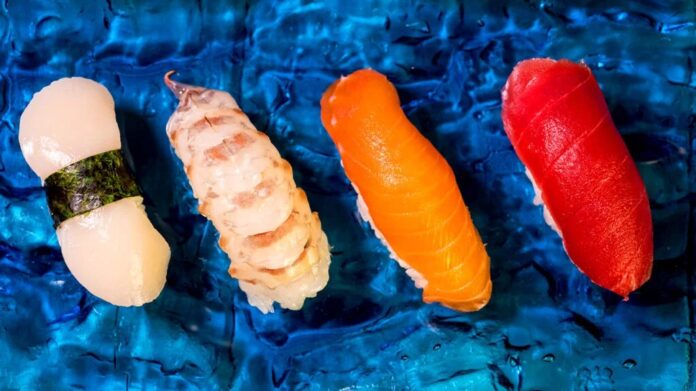
- A Japanese diet helps slow the progression of non-alcoholic fatty liver disease in people who have the condition, according to a new study.
- The study found that soy foods, seafood, and seaweed were most strongly associated with slowing the progression of fibrosis of the liver.
- The Japanese diet promotes the consumption of high-quality foods and a lower intake of sugar, saturated fats, and sodium.
A new study has found that following a Japanese-style diet can help people with non-alcoholic fatty liver disease (NAFLD) slow its progression. The authors of the study tracked the diet and disease progression of 136 people with NAFLD being treated at the Osaka Metropolitan University Hospital in Japan.
Researchers scored the diet of each individual according to its adherence to the 12-component Japanese Diet Index, or mJDI12. High mJDI12 scores were associated with a slowing of the progression of liver fibrosis that accompanies NAFLD.
The Japanese diet consists of 12 foods and food groups:
- rice
- miso soup
- pickles
- soy products
- green and yellow vegetables
- fruits
- seafood
- mushrooms
- seaweed
- green tea
- coffee
- beef and pork
Within the Japanese diet, people who consumed more soy, seafood, and seaweed enjoyed the most significant suppression of liver fibrosis progression.
The researchers also tracked the effect of the diet on muscle mass and found that people who ate more soy products built a greater amount, in addition to having low rates of fibrosis progression.
The study is published in MDPI.
NAFLD is a largely symptomless condition in which fat builds up in the liver, potentially affecting the function of the organ, although it does not directly damage it.
With NAFLD, a person is at
Dr. Muhammad Nadeem Aslam, assistant research scientist in the Department of Pathology of Michigan Medicine at the University of Michigan, who was not involved in the study, explained to Medical News Today the mechanics of how the disease develops:
“Utilization of excess fat, particularly saturated fat, along with processed carbohydrates — fructose, glucose, and sucrose — and too many calories lead to an imbalance between fat accumulation and breakdown in the liver, with fat buildup in the liver being the consequence.”
Michelle Routhenstein, heart health dietitian at EntirelyNourished.com, who was also not involved in the study, said:
“Foods that are rich in refined sugars, or saturated fat, salt, or trans fat can all promote fatty liver disease by increasing inflammation and insulin resistance and by adding more oxidative stress on the body.”
“While fatty infiltration is generally well-tolerated, the excess accumulation of lipids — including triglycerides, free fatty acids, and cholesterol — in the liver can result in cellular stress with the generation of reactive oxygen species,” Dr. Aslam elaborated.
Examples of NAFLD-promoting foods include hydrogenated oils, fried foods, juices, soda, and processed foods, noted Routhenstein.
The three most influential foods cited in the study have their own benefits, and share at least one attribute: They are low-fat.
“Soybeans, for instance, are rich in fiber plant proteins that are low in saturated fat,” said Dr. Aslam.
Routhenstein added that soy is “associated with higher muscle mass, given it is a complete protein which contains all essential amino acids to support muscle protein creation.”
“Seafood (mainly fish) is rich in omega-3 fatty acids and vitamins such as D and B2 (riboflavin). Fish is also rich in calcium and phosphorus and is a great source of minerals, such as iron, zinc, iodine, magnesium, and potassium,” said Dr. Aslam.
Routhenstein cited the anti-inflammatory and antioxidant properties of seafood for its potentially suppressive effect on fibrosis progression.
“Japanese seaweed is rich in polyphenols, vitamins, and minerals. Most edible algae contain a unique set of nutrients,” added Dr. Aslam, as well as vitamins.
Another diet known to be beneficial for people with NAFLD is the Mediterranean diet. It emphasizes plant-based elements, fruits, vegetables, nuts, legumes, whole grains, and lean meats.
Routhenstein cites one food in the mJDI12 index — green tea — as being especially helpful for NAFLD due to its antioxidant content.
It “has been shown to be protective against fatty liver disease because it contains about 200-300 mg of Epigallocatechin-3-gallate (EGCG) in one cup,” said Routhenstein.
Dr. Aslam mentioned antioxidant-rich coffee beans as also being associated with an overall lower risk for NAFLD.
“Raspberries are rich in insoluble fiber that helps create a short chain fatty acid in the gut called butyrate which studies have shown to be helpful in the reversal and prevention of fatty liver disease,” added Routhenstein said.
“This study emphasizes the opportunity to be proactive in your health by adding in therapeutic foods to help prevent the progression of fatty liver disease,” Routhenstein said.
Dr. Aslam expressed concern that so many Americans’ diet remains “far below dietary guidelines recommendations for healthy dietary patterns.”
“The lack of these nutrient-dense foods in the daily diets can cause diet-related chronic diseases, such as cardiovascular disease, type 2 diabetes, obesity, and fatty liver disease,” said Dr. Aslam.
Dr. Aslam extolled nutrient-rich diets, which have less in the way of sugars, saturated fat, and sodium:
“Vegetables, fruits, whole grains, seafood, eggs, beans, peas, and lentils, unsalted nuts and seeds, fat-free and low-fat dairy products, and lean meats and poultry — when prepared with no or little added sugars, saturated fat, and sodium — are nutrient-dense foods,” said Dr. Aslam.
Hits: 0











